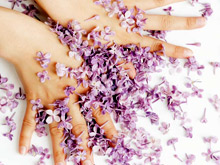Health Topics
-
Healthy Living
-
|
|
March 2010
|
| Healing with Colours |
| Shruthi Pendyala R |
| |
 |
A red rose is strikingly beautiful and all about love. But if the same rose with the same sweet smell was grey in colour, well, it would most certainly lose its significance. A rose by any other name may smell as sweet, but by a different colour, may not. |
Colours do affect our thought process in subtle ways. That’s why people feel blue when they’re sad, go green with envy, grow pink with embarrassment, and see red when they are angry. Apart for the mood altering qualities, colours are also known to have healing properties
The History
Though the term ‘colour therapy’ has come recently, the idea existed from ancient times. Warriors painted themselves in reds, blacks and browns as they believed these colours made them look fierce. Tribal women dressed themselves in bright colours to look attractive. The ancient Egyptians too understood the importance of colour - and they used colour to heal. They built temples for healing, where the rooms were coloured in different colours. The Chinese practised colour healing too, called the nei ching, nearly 2000 years ago.
India too has credited colours with incredible healing power from ancient times. Sages understood the healing vibrations of different colours and how they helped cure aliments, this is reported in Atharva Veda; where they connect the seven colours of the rainbow (violet, indigo, blue, green, yellow, orange and red) to the seven energy centres, also known as the chakras, of our body for healing purposes. Each chakra is further related to a certain gland, so they believed that the proper use of a specific colour helps cure that body ailment concerned.
Another aspect of colour therapy is the close relation the five elements of the body: fire, air, water, ether and earth, have with colours. Fire is associated with red, air with green, water with deep blue, ether with light blue and earth with yellow. Thus colour therapy draws the vibrations and energy from the five elements and colours. Together combines them to better our body’s ailments. These ancient beliefs and practices are what we still carry forward and have proved to be beneficial in today’s practice of colour therapy.
Practice of Colour Therapy
The following are the colours of the rainbow and some of the illnesses they are known to cure with their vibrations.
Violet is useful in treating people who are excessively agitated emotionally. It also helps compulsive eaters calm down and control their compulsion to eat.
Indigo stimulates the intellect. It gives a person a sense of courage, authority and inner calmness. It is useful in treating diseases of the ear, nose and eyes, and for sinus problems. It is also used for curing varicose veins, diseases of the nervous system, boils, ulcers and skin disorders.
Blue has a cooling effect; it helps people who are feeling frightened or flustered. Meditating on the colour blue before one sleeps helps to ward off nightmares. It is recommended for people suffering from shock, inflammation and nervous breakdowns.
Green helps to calm stressed out nerves and is good for people with heart conditions. It stimulates growth and therefore helps heal broken bones and facilitates re-growth of tissue. Green is recommended for pregnant women to create a serene atmosphere.
Yellow stimulates the intellect and has a cheering effect on people. It has been found to be useful in facilitating the digestive process and in curing skin problems.
Orange like the fruit itself, the colour is also energizing in nature. It is useful in treating gallstones, digestive ailments, chest ailments and arthritis. It helps to lift the spirits of people who are depressed or lonely.
Red stimulates the release of adrenaline in the bloodstream and causes hemoglobin to multiply, resulting in greater strength. Dressing up in red (and seeing this colour often) is good for patients suffering from anemia and other blood related conditions.
The Therapy
Simply dressing your self or re-decorating your house in a certain colour does not mean colour therapy. Like said earlier colour therapy uses the five elements of the body- fire, earth, air, water and ether in combination with the colours, and uses their energy to cure your body’s ailments.
In an attempt to draw energy from the five elements and the colours, a colour therapist uses coloured bottles choosing a colour according to the patient’s need. He then fills it 3/4th with water; the remaining space in the bottle is filled with air. The bottle is kept out in the sun for a period of 72 hours. During this time, the sunlight filters through the coloured bottle and mixes with the water and air thus combining the energy and vibrations of the colour and its associated element. The patient is then required to drink this water to help cure his illness. Along with this, a colour therapist might also suggest that you eat foods of the chosen colour such as tomatoes if the colour red is your recommended colour or leafy vegetables if it’s green. He might also suggest that you use coloured bed lamps or other props to enhance the effects of colour on you.
So it’s clear that colour therapy is a form of therapy using not just the different colours of the rainbow but also light and the five elements.
Remember though, that this is only a base idea of the beliefs of colour therapy. For more detailed and accurate readings, do consult a professional. |
|
|